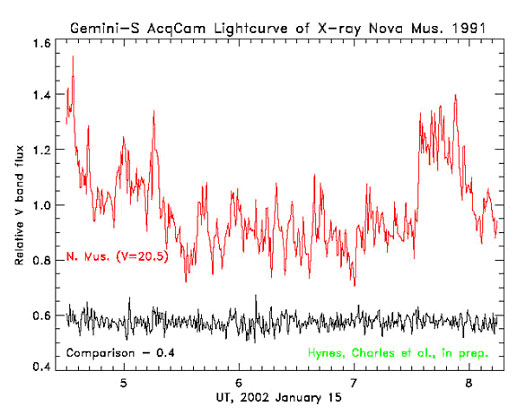Binary stars evolve in interesting ways. The more massive star in a pair evolves faster and may explode as a supernova if its original mass is greater than about 7 times the mass of our Sun. The result is that either a neutron star or a black hole is found orbiting the lower-mass companion star - as is the case with A0620-00. This system consists of an X-ray novae star, powered by the sporadic accretion material from its companion, a K5 main-sequence star. The relative faintness of the secondary star has allowed the measurement of the radial velocity of both the accretion disk around the black hole and the companion star. The black hole mass is still not well known; the most recent estimate is 11.0+/-1.9Msun (solar mass) ("A Multiwavelength, Multiepoch Study of the Soft X-Ray Transient Prototype, V616 Monocerotis (A0620-00)," The Astronomical Journal, Volume 122, Issue 5, pp. 2668-2678, November 2001). A more robust measure is that the mass has to be greater than 2.72+/-0.06Msun ("Spectroscopy of A0620-00 - the Mass of the Black-Hole and an Image of its Accretion Disc," The Monthly Notices of the Royal Astronomical Society, Volume 266, Issue 1, p. 137, January 1994).
Soft X-ray transients (SXT), also known as X-ray novae and black hole X-ray transients, are low-mass X-ray binaries characterized by long periods of quiescence punctuated by dramatic X-ray and optical outbursts. While the quiescent periods that allow us to study the accretion disk properties are not so time-dependant, they are more challenging to observe. While it is difficult to explore the quiescent state in the X-ray domain due to low photons counts, it is possible to make these observations within the optical range using a large aperture telescope that allows high time resolution. Robert I. Hynes (formerly with the University of Southampton; currently with the University of Texas at Austin) and his collaborators have embarked on a study of aperiodic optical variability of SXTs, using the Acquisition Camera on the Gemini South telescope, in order to explore the source of the microflares on short timescales.
Optical flares of A0620-00 are seen on much shorter timescales than ever reported before, with rise times as low as 30 seconds or less. In addition, the power-density spectrum of A0620-00 appears to exhibit band-limited noise closely resembling the X-ray power-density spectrum of black hole candidates in their low state. The flares are clearly associated with the accretion flow rather than with an active companion; this is shown by a correlation between the variability amplitude and the fractional disk contribution to the spectrum. Whether microflares originate in the outer disk, or are driven by events in the inner region, has not yet been resolved. Analysis of the power-density spectrum of A0620-00 shows a low frequency break at ~10-3 Hertz. Assuming that the break frequency scales linearly with the size of an inner evaporated region, then this region has size ~104 RSchwarzschild in A0620-00 during its quiescence period.
Figure 1. Light curve of A0620-00. The comparison star has the same average brightness (visual magnitude ~18) as A0620-00, but has been set downward by 0.15 units. The fits to the ellipsoidal modulation are based on a double sinusoid (fundamental on the orbital period plus first harmonic). The insets show close views of a selection of flares.
Figure 2. Light curve of XN Mus 1991. The slow variation over one phase is from the ellipsoidal modulation as in A0620-00. Large amplitude aperiodic variability is dominant, to the extent that the contribution from the ellipsoidal variation is not obvious. The large and extended flare at the end represents a net increase of about 40 percent, with an e-folding time of ~50 seconds.
The details of this work are presented in the paper "Fast Photometry of Quiescent Soft X-ray Transients with the Acquisition Camera on Gemini South," The Monthly Notices of the Royal Astronomical Society, Volume 340, Issue 2, pages 447-456, April 2003.

